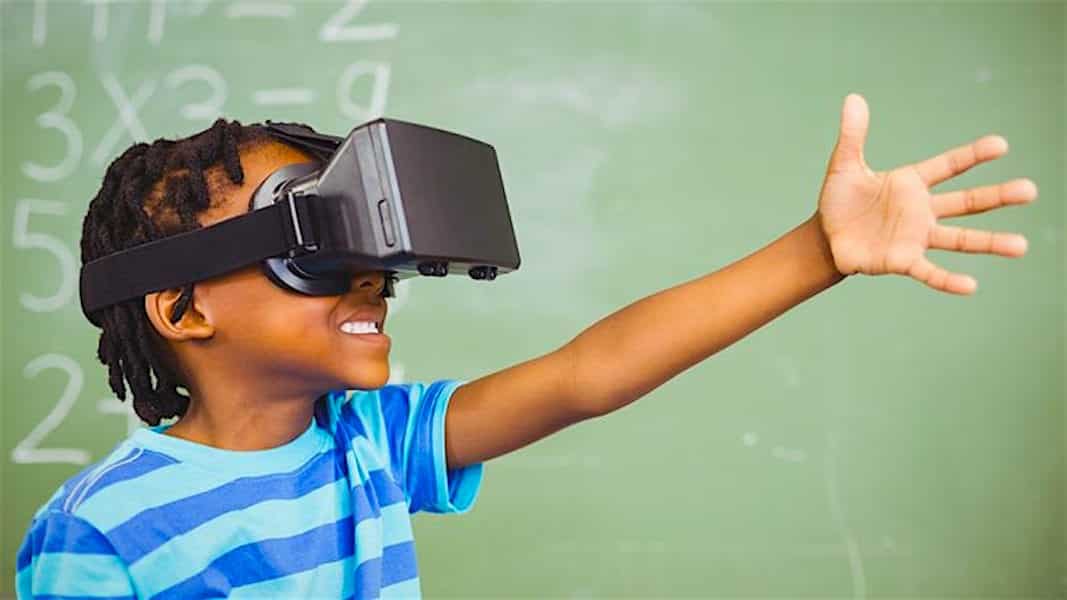Five research-based ways to use VR for learning
By Tanner Higgin
![]() While we’ve been inundated over the past few years with the promises and potentials of virtual reality (VR), it’s been tough to slice through the hype to find facts, especially the kind of trustworthy research on VR adoption, effects, and learning potential educators need. Our new Common Sense research report, Virtual Reality 101: What You Need to Know About Kids and VR, helps bring some clarity by summarizing the existing body of studies.
While we’ve been inundated over the past few years with the promises and potentials of virtual reality (VR), it’s been tough to slice through the hype to find facts, especially the kind of trustworthy research on VR adoption, effects, and learning potential educators need. Our new Common Sense research report, Virtual Reality 101: What You Need to Know About Kids and VR, helps bring some clarity by summarizing the existing body of studies.
First things first, VR has yet to be widely adopted. Only 21% of households have a headset and one can assume this percentage is far lower for classrooms. Even so, VR continues to fascinate us with its possibility, and it’s especially popular among kids, 70% of whom (ages 8 to 15) express interest in it. Since teachers are always looking for new ways to excite students, some innovative, well-supported educators have been experimenting with VR thanks to relatively low cost platforms like Google Cardboard or any of a number of sub-$100 budget headsets.
If you’re one of these pathbreaking educators, or just VR-curious, how can you make sure your lessons are grounded in best practices? Here are five key tips.
 1.) Be especially selective when it comes to what students play.
1.) Be especially selective when it comes to what students play.
VR can provide students with experiences that feel very much like actual life, especially when it comes to young kids. This means that when it comes to content, you should choose experiences that you’d want your students to have in real life. The good news is that well-chosen, pro-social experiences might help students build key SEL skills.
2.) Focus on giving students experiences vs. delivering content.
It’s easy for students to get distracted by the novelty of being in VR, and that might mean they don’t absorb as much information. This doesn’t mean all is lost; try facilitating field trip-like experiences where the learning is more in the doing.
3.) Think of it as an engagement tool, not a silver-bullet for learning.
In terms of learning outcomes, VR isn’t much different than other edtech-like digital games — which isn’t a bad thing. It does, however, seem to have an edge in terms of engagement. This means VR experiences might lend themselves well to lesson or unit introductions that’ll pique students’ curiosity and lead to more in-depth activities that get learning to stick.
4.) Use VR as an empathy-builder, but be wary when it comes to young kids.
While there’s good reason to be suspicious of people who refer to VR as an “empathy machine,” there’s growing evidence that VR can help people with perspective-taking. However, when it comes to young kids, it’s probably not gonna work as well. For these kids — who don’t yet fully understand that others may feel differently from them — it’s best to work on perspective-taking in social situations.
5.) Play-it-safe by limiting VR to shorter experiences.
 VR is a bit of a wild west in terms of its effects, especially when it comes to kids and their brain development and health. Since VR has shown some significant impacts on adults, and kids are a different story in terms of their needs, It’s best to use it in moderation (i.e. 20-minute chunks) until more research has been done.
VR is a bit of a wild west in terms of its effects, especially when it comes to kids and their brain development and health. Since VR has shown some significant impacts on adults, and kids are a different story in terms of their needs, It’s best to use it in moderation (i.e. 20-minute chunks) until more research has been done.
In addition to these research-based suggestions, there are some practical things to be mindful when using VR. First and foremost, make sure you have a large, open space for students to safely explore — like a library or gym. Even if you’re only using Google Cardboard, kids will want to spin around so they should each have more than an arm’s length of space all around them. A lot of VR can also be done sitting down, so students could still be at their desks. There’s also a risk of students finding VR to be disorienting, or feeling sick. This is another reason why it’s good to limit VR to short experiences, and to make sure to check in with students to see how they’re feeling.
This article originally appeared on Common Sense Education.
Author
 Tanner Higgin is Director, Education Editorial Strategy at Common Sense Education where he leads the editorial team responsible for edtech reviews and resources. Common Sense Education helps educators find the best edtech tools, learn best practices for teaching with tech, and equip students with the skills they need to navigate the digital world with confidence. Get free resources including full reviews of digital tools, ready-made lesson plans, videos, webinars, and more at https://www.commonsense.org/education.
Tanner Higgin is Director, Education Editorial Strategy at Common Sense Education where he leads the editorial team responsible for edtech reviews and resources. Common Sense Education helps educators find the best edtech tools, learn best practices for teaching with tech, and equip students with the skills they need to navigate the digital world with confidence. Get free resources including full reviews of digital tools, ready-made lesson plans, videos, webinars, and more at https://www.commonsense.org/education.
Previously, Tanner taught writing and media literacy for six years, and has a Ph.D. from the University of California, Riverside. His research on video games and culture has been published in journals, books, and online, presented at conferences nationwide, and continues to be cited and taught in classes around the world.
Prior to joining Common Sense Education, Tanner worked as a curriculum developer and researcher at GameDesk, helping to design and launch Educade.org and the PlayMaker School. While at GameDesk, he co-designed the United Colonies alternate reality game (ARG) with Mike Minadeo. This ARG is to date one of the most sophisticated to be implemented in a K-12 environment.
Outside of education, Tanner has been a Technical Writer-Editor for the Department of Defense, a web designer, and co-editor and co-creator of a print literary journal. Follow Tanner on Twitter.
Further Reading
- The Journal – Making Virtual Reality a Reality in Today’s Classrooms
- Smithsonian – How Can Schools Use Virtual Reality?
- CNN – Students swim with sharks, explore space, through VR
